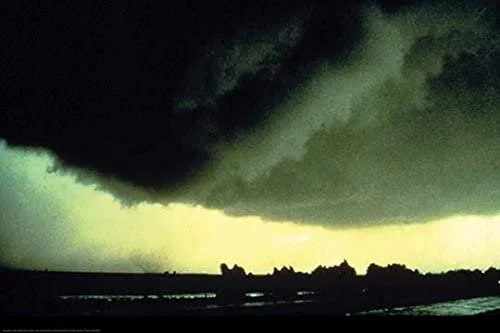This time of year I look for thunderstorms, big boomers with rolling black clouds and great flashes of lightning. I want the kind of storm that sends down sheets of rain, gully-washers, and creates worrisome winds that uproot trees and down power lines.
I wait for the kind of tempest King Lear lived through, both terrifying and thrilling, capable of washing away the grime of madness, purifying and cathartic.
For three springs and summers I lived in Kansas. There I saw storms that could lift a roof or drown a crop.
Huge walls of cloud, broiling in fury and rising into the rafters of heaven, would come rumbling across the plains late on any given afternoon turning the day into night and sending every living creatllre scurrying for cover.
I remember western Kansas in late May, broad and open like a tortilla, where thousands of acres of winter wheat stretched for mile upon treeless mile. Two immense storm fronts were converging, one frorn the north and the other from the south, and I in a frail Volkswagon was sandwiched in between.
While radio reports warned of tornadoes all around, I sped west on Interstate 70, praying for clear skies in Colorado. On either side the darkness rose like canyon walls, higher into the sky than I ever imagined a sky could be. And where the walls converged in the flat space behind me I could see the lights of small prairie towns -- Brewster, Goodland, Kanorado -- flickering and failing, flickering and failing.
I outran the storm that day, as I would outrun others in my travels back and forth across the Midwest. And though I weathered many a great and blustery storm, and waited out watches and warnings, I never witnessed a tornado.
That's like going to Paris and not seeing the Eiffel Tower, right? Or like visiting Las Vegas and not gambling.
The only tornado I've seen touched down in Boise, Idaho, of all places. The year was 1966 or 1967 and I was in grade school. Our class was outside on the playground lined up in two rows facing east doing our calisthentics.
It was a blustery day and a funny-looking mass of clouds had gathered out to the west, turning over on themselves like bread dough being kneaded. Out of that mass a little tornado, shaped like a sock, suddenly appeared. It was several miles off in the sky over the airport on the edge of town, but close enough to recognize. One by one we stopped our jumping jacks, stared and pointed.
The funnel drifted across the sky for a time, then suddenly fell toward earth. Its color changed from a soft white to dark brown and then black as it picked up dirt and debris from below. The tornado whirled about at the edge of the horizon for a few seconds, then lifted upward again, as if some puppeteer behind the clouds were jerking it back. Its color went white as it moved higher and higher into the sky. And that's when our physical education teacher ushered us indoors.
Tornadoes have occurred in every state and in every month of the year. Even Rhode Island has had its share. You wouldn't expect tornadoes at Thanksgiving, but just a few years ago 15 early-morning twisters popped out of the sky in seven sleeping counties of North Carolina a couple days after the holiday, killing four people and leaving more than 500 homeless.
Each year about 700 tornadoes are reported in the U.S. Of those, about three-quarters occur between March and July. May is the peak month. Most form in the Midwest's "Tornado Alley" between central Texas and western Ohio where there are mopre tornadoes than anywhere else in the world.
Why so many tornadoes in the Midwest? Geography.
Each spring warm, moist winds from the Gulf of Mexico flow norh across Texas. They collide with the cooler, drier air flowing east off the Rocky Mountains. This causes the moist air to rise rapidly, forming large, dark thunder cells.
As a storm rises above 40,000 feet into the sky its top may be sheared off by the jet stream. This tilts the storm, pushing cold air downward into the rising heated air. And for some reason not yet well understood, the air then begins the rotation that leads to a funnel cloud.
There are all kinds of tornado tales. I've heard of pieces of straw driven into telephone poles, of houses turned askew on their foundations or split down the middle with nary a broken glass on the side that remained standing, and of chickens sucked inside glass milk bottles.
Living between mountain ranges, we hardly ever hear weather stories like these. We get some lightning from time to time, and some heavy rains, but the forces of nature don't come calling as often in these parts or with as much fury.
That's a blessing, of course, but every once in awhile, especially this time of year, I miss the tension, the excitement and the release of a really big storm.
